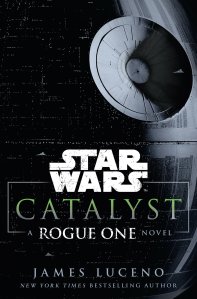Road to Rogue One – a Star Wars: Catalyst review
2016 has seen a significant expansion of the wider Star Wars universe, with novels like Life Debt and Bloodline beginning to bridge the gap between Return of the Jedi and The Force Awakens, while comics such as Han Solo, Poe Dameron and Darth Vader delved into the lives of some of the saga’s most celebrated characters.
Having already announced release dates for a number of new literary endeavours in 2017, Disney seem determined to endow their rebooted EU with as much diversity as the one they dispelled when they decided to bring Star Wars back to the big screen and even though they’ve delivered a lot of genuinely enjoyable tales to date, their revised canon isn’t without its weak links.
Battlefront: Twilight Company proved to be a little laborious last November, but was still more riveting than Lords of the Sith, which involved a less than enlivening account of a rebellion on Ryloth half a decade after the events of Revenge of the Sith. However, neither of these are anywhere near as monotonous as James Luceno’s latest contribution to the continuity, Catalyst.
Despite getting novels that revolved around Han and Leia earlier this year, I was actually a lot more curious about Catalyst because it promised to add a new dimension to the Star Wars saga while simultaneously setting the scene for Disney’s highly-anticipated spinoff, Rogue One. However, what I found upon reading it was a book that was so boring, I had to force myself to finish it.
It begins by introducing us to Galen Erso, a scientist who’s spearheading a project to produce replicated kyber crystals for power generation during the Clone Wars. After the world on which he resides succumbs to the Separatists, he and his wife, Lyra, are disgusted to discover that Dooku wants to use Galen’s research to manufacture weapons for use against the Republic. When they refuse to contribute to the Confederacy’s cause, the pair are imprisoned for several months before being liberated by an old associate named Orson Krennic.
The first few chapters are obviously supposed to establish Galen’s scientific prowess while making it clear that he’s vehemently opposed to war and all of the suffering it entails, but it’s incredibly difficult to get to grips with who he is as an individual. The author seems more concerned with continuously stating Galen’s beliefs in a mind-numbing, matter-of-fact fashion rather than attempting to provide him with any distinct personality traits or offer any reason at all for the reader to invest in him other than emphasizing ad nauseam that he’s a pacifist and should apparently be sympathetic as a result.
Unfortunately, Krennic doesn’t end up faring any better as an antagonist. Initially, he comes across as captivatingly cunning, but as the narrative unfolds, he becomes just as unbearable as Galen as we’re subjected to a plethora of passages that do nothing but reiterate how desperate Krennic is to get Galen on board with bringing the Death Star’s superlaser to life. Even though the novel encompasses a period of several years, there’s absolutely no plot progression until the very end because all Luceno does before the final chapter is relate both Galen’s reluctance to weaponize his research and Krennic’s desire to convince him to do so over and over again.
It doesn’t help that the backstory between these two isn’t explored in any great detail. Considering that this is supposed to be a prequel to Rogue One, one would assume that its primary purpose would be to depict how Galen and Krennic originally crossed paths before fleshing out their friendship. Instead, the author introduces them as estranged acquaintances without ever effectively exploring their relationship, which leaves the story feeling frustratingly hollow.
What’s worse is that when we are eventually offered some insight into Galen’s past, Luceno inexplicably decides to lay out his life story as musings in Lyra’s mind. The outcome is an incredibly contrived digression that stops the plot dead in its tracks to provide a banal bullet point summary of Galen’s early years from the perspective of his wife without doing anything to develop him as a character in the process.
This is but one of several examples of poor structuring that can be found throughout the narrative. The few instances of action it showcases are just as awkwardly inserted and unexciting. There’s something indescribably wooden about the way in which Krennic’s rescue of the Ersos is written, while a soporific subplot later on that sees an insufferable smuggler named Has Obitt joining forces with Saw Gerrera to do battle with Wilhuff Tarkin makes one of the franchise’s most famous villains seem surprisingly unimportant within the hierarchy of the Empire.
The only character that ends being remotely likable is Lyra Erso, whose tendency to display actual emotions makes her considerably more compelling that her humdrum husband and his one dimensional Imperial counterpart. To be fair, there are a handful of other interesting elements, such as the revelation of what Palpatine did with the Death Star plans from Geonosis and how the battle station’s construction essentially started as a sort of deceptive “space race” between the Republic and the Confederacy of Independent Systems.
Ultimately though, these are just a couple of minor curiosities concealed among more than three hundred pages of tedious exposition. Catalyst adds absolutely nothing of real value to the franchise as a whole and fails to set up Rogue One in any meaningful way whatsoever. I wouldn’t recommend wasting your time reading it, even if you are determined to digest everything the expanded universe has to offer.
Rating: 1/10.
Follow @davesimpson1 on Twitter for notifications about new posts.



Recent Comments